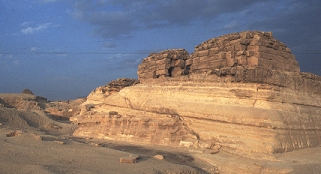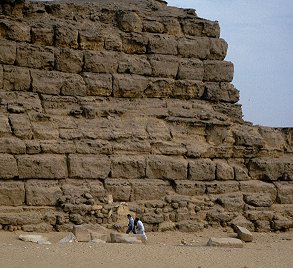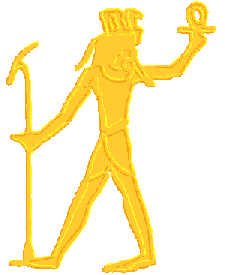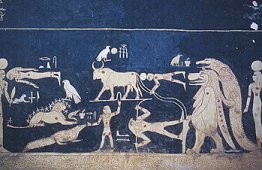I will come back to the "wider picture" now. Although I demonstrated, that the positions of the pyramids forming it are wrong, I will show now that even Bauval's definition of his wider picture is wrong. Even IF the pyramids had been at the correct positions, his thesis would not explain it.
Basis for his concept is a multi generation building project which includes all pyramids from the beginning of dyn. IV to the middle of dyn. V. Bauval writes:
"This gave me the complete stellar pattern of the sky-Duat ..and took into account all Fourth Dynasty pyramids and the cluster of small Fifth Dynasty pyramids at Abusir."[ 1 ]

|
|
|
All Pyramids? Well, nearly all. But a small group of 4th dynasty buildings object to being included in Bauval's master plan. Giza alone houses 11-12 pyramids. The three large ones, 6 satellite pyramids at Menkaure and Khufu (some of them are nearly as large as one of the Abusir pyramids he sees represented as stars), and two cult pyramids (Khufu and Kaphre). None of the smaller yramids has its star!
And what about the pyramid of Khentkawes? This is some 100 m to the east of Khafre's pyramid and was once a 3 step building. The lower course was hewn completely out of the rock and it was topped by several layers. It was long thought to be an unfinished pyramid and some Egyptologists like Miroslav Verner call it the "4th pyramid of Giza". [ 2 ] Verner is sure: "Only because of static loading problems in the lower chamber the Egyptians stopped to build it as a true 2 or 3 step pyramid."[ 3 ]. Khentkawes ruled the land for several years as a female pharaoh and had the title "King of Upper and Lower Egypt and Mother of a King of Upper and Lower Egypt" and therefore had every right to a star.What about the pyramid at Meidum? This very first pyramid of the 4th dynasty is ignored almost completely. In half a sentence on p. 29 he tells his readers that it was begun in Dynasty 3 and therefore doesn't need to be considered. Unfortunately, no living Egyptologist shares this view. They are sure: The pyramid was begun and finished by Snefru, the first Pharaoh of Dynasty 4. Who built several smaller pyramids through Egypt - which also have no place inBavals picture.

|
|
|
Or Shepseskaf, whose gigantic mastaba is covered in my travel section. This building has no need to hide behind other buildings of Dynasty. 4, it's not a small mudbrick mastaba like the ones at Saqqara, and has nothing to do with the small mastabas at Giza. And ew KNOW that it was planned as a pyramid, since the royal annals have an entry in year one of Shepseskafs regency:
"4th month 11th day: Arrival of the king of upper Egypt, arrival of the king of Lower Egypt. Unification of the two countries. Procession around the wall, Heb-Sed. Birth of the two Wp-w3wt. The king praises the gods, which unified the two countries. Selection of the building place of the kings pyramid "Kbh-Spssk3f. [///] north and south, 20 [///] all days."
Definitively: it's a planned pyramid, and its from dyn. IV, so its integral piece of the master plan. But Shepseskaf and his building are not even mentioned by Bauval!
And what about Userkaf, first king of Dyn. V. Why did he fell out of the project? He built in Saqqara, not far from Shepseskaf.
So Bauvals master scheme excludes 10 out of 16 pyramids and monumental graves of this dynasty. Not bad :-)
But it gets better: Bauval has declared, that the head of Orion (consisting of a handful of dim stars) is formed by the "3 or for little pyramids" in Abusir. Well, the second Abusir pyramid of Neferirkare had a height of about 80 meters - and was therefore 14 m higher than Menkaures Gizamid! Where the heck is the equally bright star for this one?
His claim to have included all relevant buildings into one overall plan therefore again is WRONG.
There is one thing we didn'd have asked yet. Dt the Egyptians recognise the same constellations we do? In the pyramid texts we can only read about "Sah", which is intrepreted by Egyptologists as Orion. Mainly because of the later decan tables, used for timekeeping during the night, where "Sah" rises one hour before Sirius. Unfortunately these two are the only stars or constellations we have positively indentified so far.
But even that doesn't tell us, if they really saw the same constellation, or if they had grouped the stars totalyl different. Bauval simply claims "it is so" and argues on the basis of much later myths:
"In all sky mythologies, and especially in the Egyptian one, there always existed a great bull in the sky represented by the vast constellation of Taurus (Footnote 43; See Denderah Zodiac for example). This celestial bull is closely connected with Orion the Hunter, such that classical depictions generally show Orion's left arm extending with his hand up to the 'head' of Taurus. Recently, it has been recognised that the Mithraic bull, slain by the Persian-Roman deity, Mithra, is offering an astronomical scene where Mithra is Orion and the head of the celestial 'bull' is none other than the Hyades. This imagery conforms with the classical Greek and Roman representation of Orion and Taurus, with the Hyades being the 'head' of Taurus. It is therefore interesting to note that the eyes of the bull were Aldebaran and star 311 (Epsilon Taurus)..."[5]

|
|
|
This is pretty catastrophic. It shows another fundamental error Bauval makes consistantly: He uses materials from totally different cultural contexts. What has Osiris, lord of the underworld, to do with Greek gods hunting mythical Greek bulls?
He interprets Sahu like our Orion and presents Dendera, a zodiac from the Ptolemaic period, as evidence. A zodiac which dates from more than 2000 years AFTER the pyramids, from Greek conquerors who had nothing to do with ancient Egypt. From conquerors who imported their own gods and constellations. With this argument you could try and decipher Inca legends with the Bible because these folks are now true Catholics.
Even if Persians or Romans saw bulls and hunters there is no evidence that the ancient Egyptians also saw these constellations there. Especially when you notice that the general appearance of Orion differs from that of Sahu as shown in older tombs. Sahu never has a club or mace, and is never shown striking anyone. Normally he carries a sceptre in one hand and an Ankh in his raised other hand. And normally he faces Sopdet/Isis, which is also a constellation, with Sirius as its brightest star. This orientation, especially, would be impossible with a Sahu like Orion.

|
|
|
In fact some constellations of the northern sky were identified as early as the 1960's. The ceiling of the tomb of Seti I from the 12 century BCE shows a "cut open" version of the northern sky. The Egyptians have cut the hemisphere of the sky like a spiral and rolled it out into a flat band. The north pole is the hippopotamus to the right, the other constellations were arranged clockwise around this centre. So we can see a bull on the map - around our little bear! on the other side of the sky from where we have our bull! Therefore Bauval's identification Mithraic Bull/Egyptian bull fails. Why does Bauval ignore the works of "Neugebauer/Parker, Egyptian Astronomical Texts, London 1960-1969" which he frequently quotes? Or similar work done by Kurt Locher at the beginning of the 80's[5]? Why does he try and import a foreign mythology?

|
|
|
Current work shows a divergence between Sahu and Orion. Following a paper from Kurt Locher[7] neither the pyramids of Abusir nor el-Aryan could have had anything to do with Sahu. What we see as the Belt of Orion seems to have been the crown of Sahu, the Orion nebula his hair and Rigel the chin. Kappa ORI on the other hand was the tip of the sceptre, and the rest of the stars of Sahu don't even belong to our Orion. They are from our Columbia, Eridianus and Lepus. In the sketch, after Locher, to the side I've marked the double constellation Sahu/Sodpet with red lines, our Orion with green ones. By the way: Locher's work destroys another part of Bauval's hypothesis. In his later work with Graham Hancock he wants to identify the Sphinx with a lion, and our constellation Leo with a hypothetical Egyptian lion. Therefore, the Sphinx should look at his stellar representation and give another, independent fix to 10500 BCE. Unfortunately Locher could also identify the Egyptian lion It can be found where we have our Bull. I've marked the Egyptian lion with red lines, and the stars of our Bull with blue ones.
For the rest of this story: Bauval seems not to have checked the visibility of the stars at his desired "planning era". Orion reached its lowest possible position in 11500 BCE, and the constellation was then so low that Kappa ORI only came a mere 2° above the horizon for a few days a year. So low a star is not visible, its light gets absorbed by the dust and haze of the atmosphere. Even 1000 years later the star could have only been spotted by people with keen eyes - as an unimpressive little speck. It would never have been part of a constellation, this is certain. So, why is there a pyramid at Abu Rowasch???
Conclusion: With the correct identification of Sahu we can eliminate one 4th dynasty building and the complete pyramid group at Abusir from Bauval's master plan. And because of the invisibility of Kappa ORI we can eliminate Abu Rowasch from such a plan, too The only pyramids left for Bauval's ideas are the ones at Giza...
Again, this idea of Bauval is WRONG.
On the introduction page I quoted Bauval in (3) with:
"The other version of the death of Osiris was his being killed by Seth and his body cut into (14) pieces and scattered about Egypt. The seven pyramids of the Fifth Dynasty, together with the seven pyramids of the great Fourth Dynasty gives a total of fourteen which comprised the Memphite Necropolis, at the time the Pyramid Texts were written."
Well, if you remember the information about the Osiris myth I gave on the page "The invisible God I", the story about taring apart Osiris into 14 pieces is much younger than the pyramids, it was introduced well after 1000 years after the building of the pyramids.
And there is something wrong with the number of te pyramids, too. Here a listing of the pyramids of the time in question:[8]
| Number | Pyramid 4. Dyn. | Pyramid 5. Dyn. |
|---|---|---|
| 1 | Snofru Meidum | Userkaf, Saqqara |
| 2 | Bent Pyramid | Sahure, Abusir |
| 3 | Red Pyramid | Neferirkare, Abusir |
| 4 | Khufu | Chentkaus II, Abusir |
| 5 | Djedefre, Abu Roasch | Neferefere, Abusir |
| 6 | Kaphre, Giza | Schepseskare, Abusir |
| 7 | Baka(?) el-Aryan | Niuserre, Abusir |
| 8 | Menkaure, Giza | Userkaf II, Sakkara |
| 9 | Chentkaus, Giza | Lepsius XXIV, Abusir |
| 10 | (Schepseskaf, Sakkara) | Menkauhor, Sakkara |
| 11 | -- | Djedkare, Sakkara |
| 12 | -- | Unas, Sakkara |
14 pyramids? I see at least 8 "real" pyramids in Dynasty 4, one planned and one with an undetermined "pyramidal" state. But in Dynasty 5 there are at least 12 real pyramids. 7 of them alone are located at Abusir where Bauval sees "3 or 4". Altogether we have 20-22 pyramids in these two dynasties. You don't have to be a rocket scientists to see this, all you have to do is to look at a modern book about Egypt. Again this idea is WRONG.
I'm speechless. When I read Bauval's book for the first time it seemed very plausible. He seemed to use a lot of scientific methods and many primary sources. He even spoke to scientists and was in direct contact with some of them. He did everything missing in the publications of other authors. But as we can see this is only on the surface. Below it is dark...The only point he got in this analysis was for a match of a shaft that had been previously calculated by other people. The whole shaft story is a sign of the way he really worked. Wrong shaft data, pseudo-precision and gigantic tolerances which would be appropriate for a straw hut but not for a stone building with a accuracy of 2 cm in 230 m - no way.
As long as Bauval is unable to explain the points in this analysis his theory is something for the bin. Sorry.
These Orion pages are now several years old (although constantly reworked; the German version dates back to 1997), and several things have subsequently happened. In 1999 the South African astronomer Tony Fairall published some calculations which were used in the "scandalous" BBC documentary I mentioned earlier (for more information follow this link: http://www.museums.org.za/sam/planet/pyramids.htm)It demonstrated what had long been suspected: Orion's belt didn't have the correct inclination for a match in 10500 BCE! The error is almost 10°. Fairall measured an inclination of 38° for the line through the "Pyramids of Khufu and Menkaure", but 47° for the stars they are supposed to represent. Well, that's the end of "dating Giza with the stars".
After some harsh exchanges Bauval presented a solution in the Autumn of 2000: He had never used all three stars and particularly not Menkaure's pyramid. He had worked with the diagonal of the other two pyramids, and they fitted.
Wrong again, the diagonal between the pyramids is a perfect 45° - the stars have an inclination of 54(!)°.
In a flash Bauval re-evluated the structure. Now it's a great symbolic representation which needs not be precise to the last degree. Everyone could easily see the meaning of the structure. After he posted several messages like this on bulletin boards in early 2001 I asked him, twice, how he could get a precise date out of a now symbolic representation. No answer was forthcoming.
BTW: Orion had the necessary inclination around 12000 BCE. Well, one might think that's fine. Bauval should be happy. But, no: 12000 BCE doesn't fit anywhere into the theory Bauval and Hancock have constructed around their lost civilisation, therefore this cannot be right..
I wish to thank John Wall for his help in debugging these pages and correcting all my bad grammar and typos.
| Remarks: | |
| [1] | Bauval/Gilbert p. 167 |
| [2] | Verner, Miroslav; Die Pyramiden, Rohwolt 1998, table section |
| [3] | ibd. p. 294 |
| [4] | Schäfer, Heinrich; Ein Bruchstück altägyptischer Annalen, Berlin 1902, p. 44 f |
| [5] | Bauval/Gilbert p. 184 f |
| [6] | eg. Kurt Locher, Archaeoastronomy 3 1981 |
| [7] |
Locher, Kurt; New arguments for the celestial location of the decanal belt and the origin of the s3h-Hieroglyph, Sesto Congresso Internazonale Egittologie, Vol. II, 1993 p. 279-284 |
| [8] | Verner/Pyramiden |